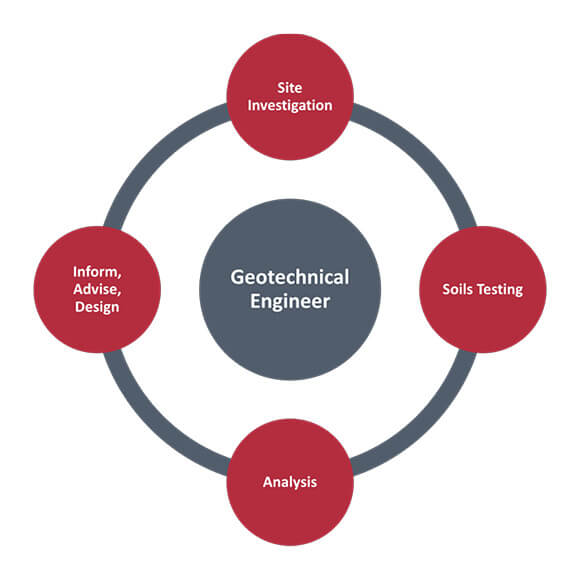The smart Trick of Geotheta That Nobody is Discussing
Table of ContentsThe Buzz on GeothetaThe 7-Second Trick For GeothetaGeotheta for BeginnersGeotheta for Beginners
They collaborate with civil engineers, structural designers, architects, and various other professionals to integrate geotechnical considerations into the overall job design and construction procedure. This needs reliable synergy, coordination, and communication to make certain that the geotechnical aspects align with the project purposes and fulfill regulatory demands.Mining & Materials Design: Principles of boring, infiltration rates, and factors affecting the selection of boring method. Attributes of nitroglycerins, firing systems and blast patterns. Blasting strategies in surface area and underground functions. Special blasting techniques at excavation borders. Vibration and noise control. Mechanical and continuous methods to fragmentation, consisting of longwall shearing and fullface boring.
Integrated evaluation of fragmentation and comminution operations. Offered by: Mining & Products Engineering.
The Best Guide To Geotheta
Bachelor's degree programs in civil, geotechnical, geological, and environmental engineering generally last 4 years and consist of general education and learning training courses in English, social scientific research, and the humanities, in addition to training courses in sophisticated maths, structural geology, and liquid mineralogy. (https://geotheta-46958753.hubspotpagebuilder.com/blog/unlocking-the-future-with-top-notch-geotechnical-engineers-at-geotheta)
Geotechnical design involves the analysis of the soil and rock conditions at a particular site, and their implications for the development of that website. As many frameworks depend on the ground for assistance, it lacks surprise that a comprehensive understanding of the ground conditions, and the suitability of foundation systems, are essential to the long-term security and efficiency of the building or framework.
Specialising in the investigation of geological formations and ground practices, geotechnical designers perform clinical examinations and screening to recognize the impact these geological formations might carry the layout and construction of structure, civil and facilities jobs. This proficiency is important for the design and building of buildings, roads, tunnels, dams, bridges, and water system and sewage systems.
The geotechnical group at Douglas Partners routinely seek advice from with designers, style engineers, programmers, and builders to make suggestions on design and growth proposals to make sure that the developed frameworks are appropriately developed for the ground conditions. As an example, the style of footing systems requires to think about the weight of the structure, the capacity of the ground to sustain that weight along with activity tolerances and reliable building and construction.
See This Report on Geotheta
This job is substantially simplified by the use our Douglas Map geospatial system which makes this details conveniently easily accessible in a simple to use internet browser user interface. A geotechnical designer will guide the boring of boreholes and examination pits to collect soil and other examples, and also evaluate surface area attributes and ground exposures to form a geotechnical design of the subsurface problems.
Depending on the job type and ground conditions encountered, lab testing may to name a few points analyze toughness, compressibility, sensitivity and/or permeability of soil and rock examples. After this data is accumulated and collected, the results are used for a geotechnical version of the website, which is normally presented as sections across the site.

A geotechnical investigation by nature can only evaluate the ground problems at the areas pierced or excavated. All-natural variants in dirt and rock conditions can take place throughout a website and in between examination locations. It is therefore excellent practice that the geotechnical engineer be retained throughout building of the project to provide on-site verification that the ground problems run into are consistent with the expectations and guidance supplied in the geotechnical examination record.
The Ultimate Guide To Geotheta
Geotechnical designers utilize their thorough expertise of soil and rock to assess threat and address troubles on varied facilities projectsGeotechnical engineering is a specialist branch of civil engineering which takes a look at the behaviour of planet materials and the application of soil and rock mechanics. Tailings Engineer. As a geotechnical designer, you will examine the physical, mechanical and chemical buildings of soil and rock in order to make structures, preserving frameworks and earthworks
Geotechnical engineering is very closely linked their explanation to and overlaps with, both engineering geology and ground design - https://www.abnewswire.com/companyname/geotheta.com_139529.html#detail-tab. It's possible to be experts in geotechnics or benefit a geotechnical business yet be known as an engineering geologist or a ground designer. As a geotechnical engineer, you'll require to: construct and keep connections with clients and various other specialists associated with the site, throughout each projectmaintain safety requirements on website be mindful of cost ramifications when you make recommendationsstudy geological maps and aerial photos from an array of sources and from various time periodsexamine construction prepares to see just how feasible they are based upon your understanding of the siteinvestigate risks or geological dangers for the sitesearch for ecologically sensitive features, such as landfill begin to establish accurate and expository ground modelsplan area investigationsdrill and evaluate examples of bedrock, dirt, groundwater and extra products oversee other experts on sitesolve technical issues as they emerge, such as unanticipated frameworks at drill sitesmonitor conditions throughout and after building to see to it structures are stable in the brief and long termadding data accumulated on site to your preliminary researchcreating geotechnical computations, illustrations, and two or three-dimensional computer system models translating the datamaking recommendations concerning the suggested usage of the website
